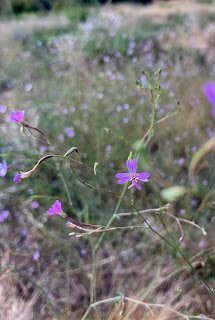For years, my go-to microphone for recording my violin (or anyone else's) in the studio has been a Cascade Microphones Fathead II ribbon microphone with a factory-added Lundahl transformer, run through an Avalon 737 tube preamp. Using a ribbon mic live is impractical for two reasons--its pick-up pattern is a figure-8, and they are too fragile for the stage. So, for live sound reinforcement, I have used an old favorite, a Sennheiser 421 dynamic mic. The last few times I've played for dances, I've noticed that he Sennheiser is a little scratchy-nasty in the high end, so I have been wondering if there was another option with the warmth of the ribbon mic. I kept seeing singers using a microphone I had associated with broadcasters--the venerable Shure SM7B, and the warm, smooth sound haunted me--that is exactly what you want for a violin when you are close-miking live, because a violin makes weird scratchy bow sounds that are right there by the instrument, but not audible from ten feet away. Somehow, the ribbon mic eliminates the bow noise, and I wondered if the SM7B would do the same. I have not seen/heard anyone using an SM7B for violin, or any other acoustic stringed instrument, in fact. If not for the pandemic, I would have booked time in a studio that had one, so I could try it out, but... not possible. So, I took the leap and I just bought one, along with a Cloudlifter CL-1, which is a gizmo that takes phantom power from your preamp, and hijacks it to add 25dB of clean gain to the signal. So here are the microphones...
From left to right...
Audio-Technica AT4050 (the windscreen is moved off behind the mic), running into an Avalon 737 tube preamp. This is my standard set up for a singer, and I thought it would make a good comparison to the other microphones.
Sennheiser 421, running into a channel of my True Systems Precision 8 preamp. This is something like my usual live sound violin setup.
Shure SM7B, running through a Cloudlifter CL-1, into a channel of my Precision 8. I did not roll off the bass, nor juice the "presence" setting--I am running it flat.
Cascade Fathead II, running into an Avalon 737.
So, what I did was record a couple of tunes onto four separate tracks, "Hector the Hero" is an air composed by Scottish fiddle legend J. Scott Skinner, and is played in Donegal (N. Ireland), and I decided to pair it with a jig from Donegal, "Hardiman's Fancy." To compare the microphones, I edited a single track (with just a bit of reverb), switching off between the microphones, at regular intervals. The tunes are in two parts, and so on "Hector the Hero," I only played it once, so I divided each section in half, and switched at that point. With the jig, I played through twice and switched on each part. Here are the specific timings...
Hector the Hero
A1/first half--0:00-0:14/S421 A1/second half--0:14-0:27/FatheadII
A2/first half--0:28-0:41/AT4050 A2/second half--0:41-0:54/SM7B
B1/first half--0:54-1:09/S421 B1/second half--1:09-1:22/FatheadII
B2/first half--1:22-1:36/AT4050 B2/second half--1:37-1:52/SM7B
Hardiman's Fancy
A1--1:52-2:02/SM7B A2--2:02-2:12/S421
B1--2:12-2:21/Fathead B2--2:21-2:30/AT4050
A1--2:30-2:39/SM7B A2--2:39-2:48/S421
B1--2:48-2:57/Fathead B2--2:58-3:09/AT4050
And here is the recording. https://palouserivermusic.com/single/46501/microphone-comparison-for-close-miking-violin
If you want to download it for some reason, you can do that free from that page...
CONCLUSION
You will make your own conclusions, of course, but here are mine. I am thrilled by the sound of the SM7B--I think it wins the comparison, hands-down. I expected it to be better than the Sennheiser, which does indeed sound a little scratchy and dull in comparison here, but I didn't expect it to be the best of the bunch. The 4050 was better with the violin than I expected, but I suspect that has to do with the Avalon preamp, which helps to make it more luscious. The Fathead was interesting--it is getting the cushy Avalon ride that I gave the 4050, but I noticed, in this close-miking arrangement, that it picked up the little thumps of my fingers hitting the fingerboard more than the other mics. In a real recording I would eliminate that by placement or EQ, but I noticed the problem more in the Fathead than the others. It is fine, but... the SM7B is superior, in my opinion.
Of course, this sets up an experiment I didn't yet do--SM7B into the Cloudlifter...and then into the Avalon preamp. Really, my point here was to see how the SM7B would do live, and so the squeaky-clean solid-state Precision 8 was the best test for a live sound, but next time I record the violin for to make a real recording, I will have to hear the SM7B through the Avalon. That it compared so well with the Fathead in this setting bodes well. And I should try the Cloudlifter on the Fathead, too.


















































